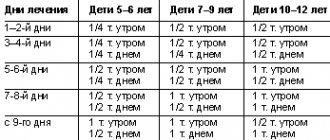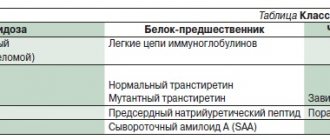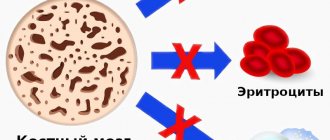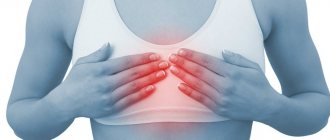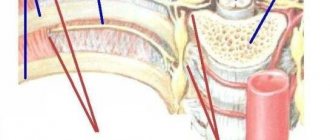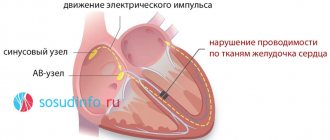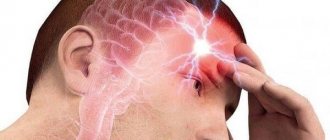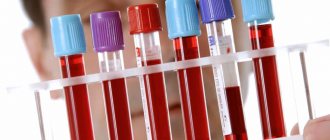© Author: A. Olesya Valerievna, candidate of medical sciences, practicing physician, teacher at a medical university, especially for SosudInfo.ru (about the authors)
Sympathicotonia is manifested by an increase in the tone of the sympathetic department of the autonomic nervous system with the appearance of characteristic symptoms - hypertension, tachycardia, fever, hunger, etc. It can be one of the manifestations of a mixed version of autonomic dysfunction or an independent form of pathology, and often requires medication and even surgical treatment .
Sympathicotonia is not considered a disease; it is a complex symptom complex due to functional disorders of autonomic regulation, which can occur against the background of another pathology or even for no apparent reason. However, this disorder cannot be left without attention, because its complications can pose a threat to the patient’s life, provoke neuroses and significantly reduce the quality of life.
Diagnosis of increased tone of the sympathetic nervous system sometimes presents certain difficulties, since the symptoms are quite varied and it is often difficult to relate one to the other, “fitting” the clinical picture into a specific disease. The diagnosis can be made by excluding pathologies of many organs (gastritis, bronchitis, arrhythmia, neurosis, etc.).
Before the fact of a functional disorder of sympathetic regulation is established, some patients manage to examine almost all organs, having done an ultrasound of the abdomen and retroperitoneum, gastro- and colonoscopy, a cardiogram, undergoing various tests and visiting specialists. Only when it becomes clear that the organs are completely healthy, specialists are convinced of the functional causes of the pathology.
Sympathicotonia is a manifestation of autonomic dysfunction (VSD), in which increased tone of the sympathetic department dominates among the manifestations. VSD as a diagnosis is not included in disease classifications, but is extremely common in people of all ages. According to some reports, up to 80% of the population suffers from this disorder, and at least a third of them need the help of specialists and prescription of medications. Among the patients, there are several times more women; symptoms are more pronounced in children, adolescents, during menopause and pregnancy.
departments of the autonomic nervous system are normally in balance; with sympathicotonia, the sympathetic department is more active
Symptoms
Because VSD affects the entire body, symptoms may also appear in one or more of its systems. The most common symptoms encountered with neurocircular dysfunction are listed below, depending on the type of disease: sympathicotonia or vagotonia.
General disorders of the body:
- high fatigue;
- weakness;
- sleep problems such as insomnia or drowsiness;
- Bad mood.
Violations by systems.
Nervous system:
- dizziness;
- headache;
- fainting;
- slight increase in temperature.
Digestion:
- intestinal problems;
- stomach ache.
The cardiovascular system::
- pain and heart murmurs;
- change in blood pressure.
Respiratory system:
- labored breathing;
- frequent shortness of breath, even with light exertion.
Urinary system:
- increased frequency of urination;
- increased frequency of urges at night.
Typically, the disease proceeds in a sluggish form or bothers the patient with attacks, they are also called vegetative crises. Crises last from several minutes to several hours. Emotional experiences, physical or mental stress, infections - all this can become a catalyst for another attack.
Causes of sympathicotonia
The causes of hypersympathicotonia are extremely varied:
- Hormone-producing adrenal tumors (pheochromocytoma);
- Stressful situations, worries, nervous overstrain, neurasthenia;
- Brain pathology and increased intracranial pressure;
- Unfavorable environmental situation, radioactive radiation;
- Changes in climate zones, frequent long-distance flights;
- Pathology of the cervical spine;
- Brain injuries, neuroinfections;
- Hormonal imbalance in adolescence, premenopausal age, during pregnancy;
- Hereditary predisposition (primary sympathicotonia);
- The pathological course of childbirth and the early postpartum period is hypoxia, trauma, infectious pathology.
As you can see, both external unfavorable factors and diseases of internal organs and the endocrine system lead to a disorder of nervous regulation, but, perhaps, the most common causes are stress, anxiety, and neuroses. With the development of autonomic dysfunction such as sympathicotonia in connection with various other pathologies, they speak of the secondary nature of this form of VSD.
Diagnostics
Diagnosing VSD at home is impossible, due to the fact that to detect the disease it is necessary to examine all organs that are bothering the patient. For diagnosis, the following manipulations are carried out:
- interpretation of urine and blood tests;
- electrocardiography;
- echocardiography;
- breath tests;
- Ultrasound of the abdominal organs;
- electroencephalography;
- echoencephalography.
Also, when identifying a disease, it is important to study the patient’s hereditary information.
Doctors note that with sympathicotonia, patients were found to have hereditary diseases, such as diabetes mellitus or hypertension, and with vagotonia, neurodermatitis, ulcers or asthma. It is genetic predisposition that is the main factor influencing the risk of developing VSD.
Sympathicotonia in children
In children, sympathicotonia is functional in nature, and symptoms often disappear by adulthood. Characteristic signs of VSD of the sympathicotonic type are:
- Emotional lability - hot temper, irritability, tendency to neurosis and neurasthenia, absent-mindedness, difficulty concentrating and learning;
- Low pain threshold, so children are sensitive to any pain;
- Good appetite with general thinness;
- A feeling of numbness in the arms and legs, more pronounced in the morning, paresthesia in the form of “goosebumps”;
- Cold and dry skin of the hands and feet, pallor (even if the body temperature rises);
- Possible causeless fever;
- Meteor dependence and poor heat tolerance;
- Symptoms of the heart and blood vessels - tachycardia, hypertension;
- Slow peristalsis and constipation.
Treatment
Despite the genetic predisposition to the disease, its development can be prevented, subject to compliance with the regime, dosage time for work and rest, as well as proper nutrition. So, if a patient has high blood pressure, it is worth reducing the amount of salt, confectionery, fatty foods, and fried foods consumed. With low blood pressure, doctors recommend not to indulge in foods containing iodine, sodium and potassium in large quantities, to maintain a sleep schedule, not to overwork, and to avoid stressful conditions.
In the fight against the disease, experts focus on a non-drug method, namely:
- massage;
- acupuncture;
- physiotherapy;
- water procedures.
To reduce and alleviate symptoms, medicinal herbs are used:
- Eleutherococcus;
- ginseng root;
- lure;
- Aralia;
- motherwort;
- valerian;
- hawthorn.
In case of low effectiveness of the described methods, doctors resort to the use of pharmaceuticals, which are selected separately for each patient. In addition, antidepressants, sedatives, vitamin-mineral complexes, and drugs that restore blood supply to the brain can be used.
For successful recovery, regular examination is required - once every 3-6 months. Neurocircular dysfunction, as a rule, intensifies in spring and autumn, so it is better to prescribe all therapeutic measures at this time of year.
In case of untimely or poor-quality treatment, dystonia progresses and leads to the appearance of a variety of pathologies in the body, but if you follow the doctor’s instructions and monitor the course of the disease, the prognosis is favorable.
Autonomic dystonia syndrome
The basic principles of treatment are as follows:
- individuality - the onset and development of the disease, the severity of its course are considered, symptoms are studied;
- integrated approach - treatment includes various types of therapeutic effects on the body (drug therapy, physiotherapy, physical therapy, acupuncture, herbal medicine, etc.);
- long-term implementation of therapeutic measures - to eliminate changes in the autonomic nervous system it is necessary to spend more time than for the formation and appearance of disorders;
- timely therapy. To achieve success in treatment for VDS, it is better to start it in the initial stages of the disease;
- psychotherapeutic activities are carried out not only with the sick child, but also with his parents
Therapy for Autonomic Dystonia Syndrome includes a complex of non-drug and medicinal methods. Only in case of severe or prolonged manifestations of SVD, medications are used. For mild cases of the disease, non-drug correction methods are used in combination with routine and psychotherapeutic measures. It is important for the patient to maintain a daily routine and not overload himself with physical and mental activity. Walking should be at least 2 hours a day, night sleep should be at least 8-10 hours. Older children and teenagers should spend less time watching television programs, working on the computer, spending time should be no more than 1-1.5 hours a day. day. Parents need to take care of creating a normal psychological climate, eliminating neuropsychic overload and conflicts in the family and school.
Correction of autonomic disorders is carried out by changing the diet. To do this, reduce the consumption of table salt, sweets, fatty foods, flour products, tonic drinks and increase the consumption of potassium and magnesium salts with food, which are found in cereals, fruits, legumes and vegetables, replace sunflower oil with olive oil - these are the basics of diet therapy for SVD.
Children and adolescents diagnosed with hypotensive VDS are recommended to eat food containing a sufficient amount of liquid, tea and coffee only in combination with milk, marinades, kefir, chocolate, milk, pea and buckwheat porridge, i.e. products that affect the stimulation of the autonomic nervous system and adrenergic receptors that control vascular tone. In the hypertensive form of SVD, it is reasonable to moderately limit the consumption of table salt, with the introduction of foods that reduce vascular tone and the activity of autonomic innervation, such foods include barley porridge, carrots, beans, salads, milk, spinach, and cottage cheese. For the cardiac type of SVD, it is recommended to eat food that improves the properties of the blood, introducing vegetable oil, gray porridge, citrus fruits, and a moderate amount of spices into food. With all options, it is necessary to take honey at night for at least 2-3 months, various juices, compote of sea buckthorn, viburnum, rose hips, rowan, cranberries, apricots, carrots, chokeberries, lingonberries, dried apricots, raisins, infusions, as well as mineral waters .
Exemption from physical education and sports is not recommended. The only exceptions are forms of the disease with a crisis state. In these cases, it is necessary to do therapeutic exercises. Swimming, hiking, skating and skiing, cycling, active games, dosed running and walking have a beneficial effect. Therapeutic massage of the cervical-collar area and spine is beneficial (the course is 15-20 sessions).
For the hypotensive type of SVD, preference is given to active types of physical activity, such as dancing, shaping, tennis, etc. For the hypertensive type, the following sports are recommended: walking, swimming, hiking. For cardiac diseases - slow running, swimming, badminton. For all types of SVD, group sports (basketball, football, volleyball) are not recommended.
Treatment with physiotherapeutic methods, such as sinusoidal modulated currents, ultrasound, inductothermy, galvanization using the reflex-segmental technique or the method of general influence, electrosleep, paraffin and ozokerite applications on the cervical-occipital zone is considered successful; it is especially good to use electrophoresis of drugs on the upper cervical spine. For vagotonia, electrophoresis is performed with calcium, mesatone, caffeine, for sympathicotonia - with a 0.5% solution of aminophylline, papaverine, magnesium sulfate, bromine. The procedures are performed on the cervical-collar region. For SVD of the mixed type, electrophoresis of a 1% solution of novocaine and 0.2% solution of potassium iodide is used according to the orbital-occipital technique and endonasal electrophoresis of a 2% solution of novocaine. Such procedures are carried out every other day. The course consists of 10-12 procedures; if necessary, treatment is repeated after 1.5-2 months.
Drug therapy is administered after applying the complex of measures described above or in combination with them. It begins with drugs that are widespread and have a small number of side effects (valerian, bromine, zamanika, etc.). The treatment is long-term, so the drugs are prescribed gradually, replacing one after another, while alternating different methods of influencing the body. Medicines are selected individually, strictly observing the age-specific dose. In preschool age, psychopharmacotherapy uses, first of all, sedatives of plant origin: valerian, motherwort, hawthorn, peony, novopassit, soothing herbal mixtures containing mint, hops, oregano, valerian, hawthorn, wild rosemary, sage, motherwort, St. John's wort. Sedative preparations are used for a long time - up to 6 months, in courses with breaks: the first 2 weeks of each month are used, then a break is taken at the beginning of the next month.
Tranquilizers and antipsychotics have a sedative effect and therefore form part of the therapy. Tranquilizers reduce neurotic symptoms such as fear, apprehension, anxiety, have a good effect in functional cardiopathy (extrasystole and cardialgia), vascular dystonia, falling asleep becomes easier, some of the drugs can have an anticonvulsant effect. For sympathicotonia, hypersympathicotonic reactivity, use: seduxen (diazepam) 5-15 mg/day, tazepam (oxazepam) 15-30 mg/day, Elenium (chlordiazepoxide) up to 5-15 mg/day, etc. These drugs are not recommended for children having an initial vagotonic tone, with a tendency to hypotension. For vagotonia, amizil is prescribed at a dose of 1-3 mg/day. For mixed variants of SVD, use meprobamate 0.2-0.8 g/day, phenibut 0.25-0.5 g/day, belloid and bellaspon (bellataminal) no more than 1-3 tablets per day in accordance with age. All tranquilizers for children with SVD and functional cardiopathy are prescribed in minimal doses, after which they are slowly increased. It is better to take the medicine after lunch or in the evening. The duration of treatment with small doses is up to 2 months. and more.
Neuroleptics reduce the response to external stimuli. Children diagnosed with SVD are treated with “mild” neuroleptics, which are usually well tolerated, in case of ineffectiveness of tranquilizers: frenolone 5-15 mg/day, Sonapax (Melleril) for preschool children 10-20 mg/day, schoolchildren 10-20 mg/day 20-30 mg/day, teralen 5-15 mg/day. The treatment includes a combination of seduxen, amizil and sonapax.
Further drug treatment is prescribed depending on the type of dystonia in the child. A good therapeutic effect of sedative herbal infusions is observed in the correction of arterial hypertension. Sometimes antispasmodic medications are used (dibazol, papaverine, no-shpa). In the treatment of high blood pressure, it is possible to use the calcium antagonist nifedipine.
Treatment of arterial hypertension begins with the use of small doses of drugs orally to avoid an excessive decrease in blood pressure. If blood pressure cannot be controlled when the therapeutic dose of one drug is reached, combination therapy is used.
Calcium antagonists and ACE inhibitors are often used. These drugs can improve the quality of life of patients due to the relatively low frequency of adverse reactions and high efficiency.
The ultimate goal of treatment of arterial hypertension in older children is a persistent reduction in diastolic blood pressure to a level not exceeding 80-90 mm Hg. Art.
Given the considerable prevalence of the disease, every teenager needs to be screened to determine blood pressure levels, even in the absence of any disease. Children with identified arterial hypertension require a detailed study to establish the cause of increased blood pressure and determine further therapy aimed at preventing damage to vital organs and systems.
In cases of severe arterial hypotension, bradycardia, and vagotonia, psychostimulants of plant origin are prescribed - tincture of lemongrass, ginseng, zamanikha, aralia, extract of eleutherococcus and rhodiola. Sometimes it is possible to combine them for a short period with small doses of acephen, caffeine-sodium benzoate, caffeine.
For children with SVD against the background of residual organic changes in the central nervous system, the use of neurometabolic stimulants (cerebroprotectors - nootropil, pangogam, etc.) is indicated. To improve microcirculation, Trental, Cavinton, Stugeron are prescribed, taking into account the data of the initial vegetative status. For sympathicotonia, potassium preparations and vitamins (B4, E) are used, and for vagotonia, pyridoxal phosphate (vitamin B.6).
Currently, in the treatment of almost any form of SVD, dietary supplements of plant origin, which include coenzymes, microelements and vitamins, are widely used.

